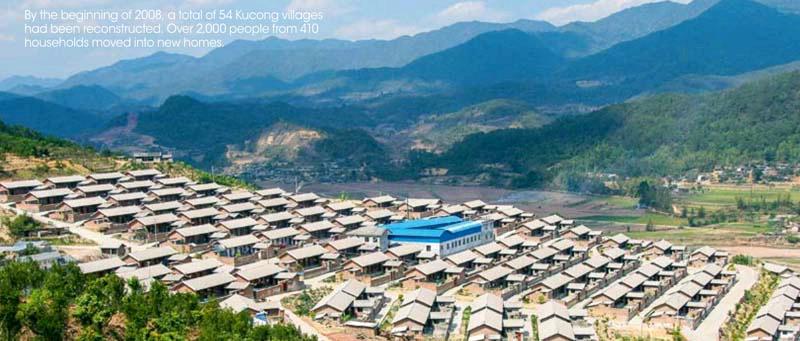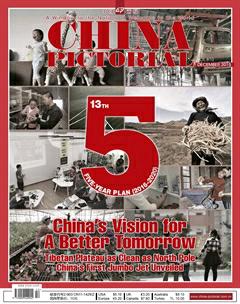Kucong Villages,Refreshed Outlook Year by Year
by+Yu+Ge
In the middle of the Ailao Mountain in the Hengduan Moun- tains of Yunnan, there is an ethnic group called ‘Kucong people. In August 1987, by identifying the characteristics of this group, and in accordance with the will of all Kucong people, Yunnan Provincial Government recognized the Kucong as part of the Lahu ethnic group and decided to resume the Lahu title for more than 30,000 of the Kucong in the province from August 9, 1987. There are 15,263 Kucong people inhabiting Zhenyuan County of Puer City, which accounts for nearly half of the groups population in the province.
Kucong people directly entered socialism from the end of primitive society. Before the 1950s, slash-and-burn cultivation and hunting and gathering remained their main mode of production. Since the founding of the Peoples Republic of China, both central and local governments have laid great importance on the development of Kucong people and their region. The efforts were redoubled after the Central Government launched the “8-7 National Poverty Reduction Program” in 1994, which was aimed at basically eliminating absolute poverty for 80 million people in seven years. Aggregate funds to Kucong ethnic minority areas for poverty alleviation had reached almost 130 million yuan by 2008.
As the production and living environment is extremely bad due to high mountains, steep slopes and crisscrossing ravines in the area of Kucong people, improvements in production and living standards in the area were slow. Until 2005, per capita net income was only 187 yuan, with per capita ration 170 kilosgrams and 6,600 people still living in cottages or bamboo houses.
Diao Yinghui from the Publicity Department of Zhenyuan County of Puer City vividly recalls that in July 2005, a domestic media team came to explore the history of the ancient tea route in Guizhou, Sichuan and Yunnan areas. When they arrived in Kucong villages deep in the mountains, some journalists remarked,“We cant believe there are people still living in such backwardness in the alpine mountain region.”
The journalists then published a report titled “Kucong People from Yunnans Zhenyuan Still Live in Poverty”. In November, the Central Government put forward a plan to “implement supportive policy in areas inhabited by ethnic minorities with a smaller population, and take effective measures in alleviating Kucong peoples poverty as soon as possible.”
Under the circumstances, when most regions were projecting reports of their increased GDP, exposing Kucong peoples poverty was not easy. However, on the issue of supporting Kucong people to overcome poverty and achieve prosperity, Puer Citys position was consistent with the policy of Yunnan Province. In Zhenyuan where most Kucong people resided, annual revenues were only 30 million yuan as opposed to expenditure of 200 million yuan. Therefore, exclusively relying on the local government to help Kucong people was far from enough. What was also needed was external publicity to attract attention of all sections of Chinese society.
Owing to thorough research and close coordination by the Poverty Alleviation Office of the State Council, a campaign for helping and supporting the poor was launched. At the end of 2005, Yunnan Provincial Government set up a specialized “guiding group for poverty alleviation and supporting development projects of Kucong people in Zhenyuan County,” followed by the introduction of a five-year plan for the purpose. In addition, the General Political Department of the Peoples Liberation Army, together with Shanghai Municipal Government and Baosteel, participated in the campaign.
Diao Yinghui reveals that Kucong people received only 3.8 years of education on average. Due to low level of social development, the initial support should start from teaching them how to wash their face and brush their teeth. In addition, since they were not used to living in the plains after relocation with government support, some villagers moved back to the mountains. “We had to persuade them to move down again, and ask specialized technical personnel to teach them how to cultivate rice,” Diao explains.
In order to help Kucong people adopt a civilized way of life and achieve prosperity through hard work, local officials were assigned to provide poverty reduction aid to designated families. At a crucial stage of this process (2006 to 2007), director Chen Ju from the countys poverty alleviation office could not go home for a month. The funds under her control for poverty alleviation were as much as 40 million yuan. When a poor family she assisted moved down from the mountain, she spent nearly 8,000 yuan buying them two pigs, together with fodder, clothes, sofa, TV, etc. The family of three was allocated 0.5 acres of land, two vegetable plots and 0.66 acres of mountain forests. Life depended on cultivating rice, growing vegetables and raising pigs.

